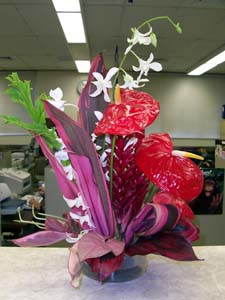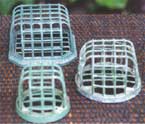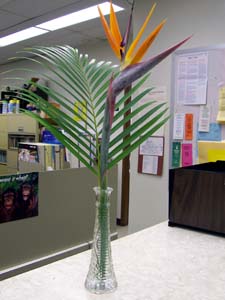
(Flower arrangement by Richard Criley)
You have some flowers and want to make a very simple flower arrangement for your home or apartment. Now, we're not talking about something fancy such as those arrangements found at a wedding or party. We mean simple! When thinking about flower arrangements, we often dwell of those elaborate kinds of arrangements. And we feel intimidated and overwhelmed!
But if just want to make a simple flower arrangement for your home, here are some tips. Remember, it doesn't have to be "perfect." So have fun arranging flowers!

(Flower arrangement by Richard Criley)
Question: What kinds of flowers can I use?
Answer: Use whatever kinds of flowers you like or are readily available. Fresh flowers are typically available at any florist, supermarket, garden shop, farmer's market, and from your own garden. Start by choosing the colors you want to work with.

(Flower arrangement by Richard Criley)
Q: What else do I need besides the flowers?
A: To accent the flowers you probably want some greens, foliage, or filler flowers.
Q: What about vases?
A: Vases come in a myriad of sizes, shapes, colors, and materials. Again, choose what you like or is available. Most likely, you have a collection of vases at home from flower arrangements you have gotten over the years. Thus, a vase is readily available, and there is no need to buy one.

(Flower arrangement by Richard Criley)
Q: What tools do I need?
A: Sharp shears, knife, or scissors. A sharp edge is desirable, not only because it is easier to cut the materials, but a sharp, even cut will allow water to enter the flower stems. A ragged, crushed cut edge may inhibit water and food absorption and will make your flowers fade faster.
Q: How about a floral frog or floral foam?
A: Floral frogs or floral foam can be used to help hold up the flowers and foliage in an arrangement. Floral foam is inexpensive and convenient for making arrangements. Floral frogs are reusable and cost less in the long run. They are inexpensive and come in many sizes, shapes, and styles.

Q: What are some simple rules of thumb for flower arranging?
A: Even without formal floral design training, you instinctively know what is most pleasing to your eye. After all, most people haven't taken clothing design classes, and they've been choosing their clothes and wardrobe all their lives.

Q: Moving from the general to the specific, how about single flower arrangements?
A: They are simple, elegant, and easy on the budget. A single rose or other flower in a bud vase is always elegant. Single blooms can also be placed in tiny vases and containers. Float smaller blooms in wineglasses or teacups, or float larger blooms in bowls.

Q: How do I make loose flower arrangements?
A: Fill your vase with water and strip the stems so no leaves are covered by water. Cut the stems to about twice the height of your vase, leaving several stems a little longer for the center or rear of your arrangement.
Insert stems of foliage and filler flowers. Criss-cross the stems, creating a network that will help hold the flowers in place. Start at the rim of your vase and work toward the center. Place the longest stems in the center or rear of your arrangement.

Q: How do I make a bud vase arrangement?
A: Fill a narrow necked bud vase with water. Cut the flower stems to about twice the height of your vase. Strip the stems so no leaves will be covered by water and place the flowers in the vase. Add a stem or two of foliage or a curly twig.

(Flower arrangement by Richard Criley)
Q: How do I care for my arrangement?
A: If the water level in the vase is low, add more water. The flowers can be watered every few days using plant food. If the water is cloudy (a sign of a bacteria infestation), you need to clean the vase and change the water. Remove any dead or dying flowers, and replace them with fresh flowers.
Q: Any last advice?
A: Remember, flower arrangements don't have to be "perfect." You are not a professional florist who makes hundreds of arrangements a week. As long as you like the arrangement and it makes you happy, it is indeed a "perfect" arrangement.
Flower arranging, Home & Garden Television
Ikebana (Japanese style), Home & Garden Television